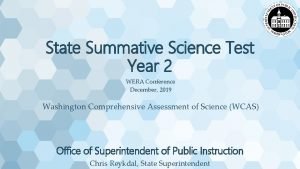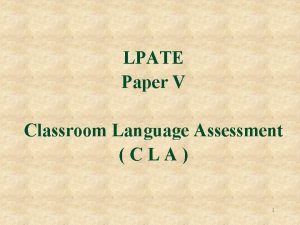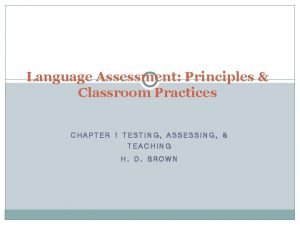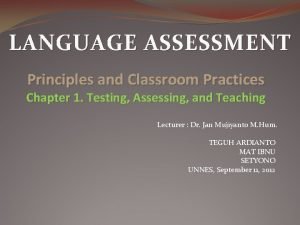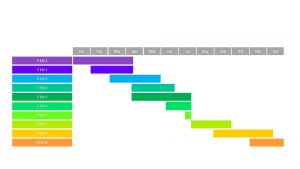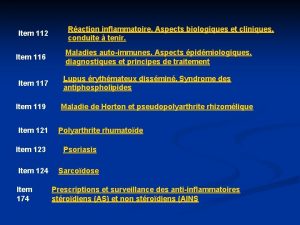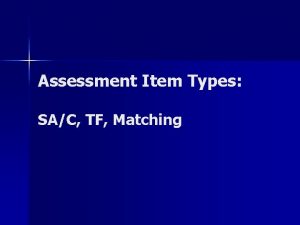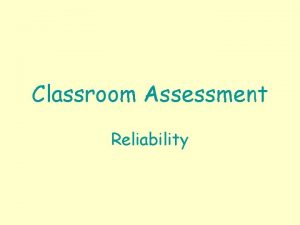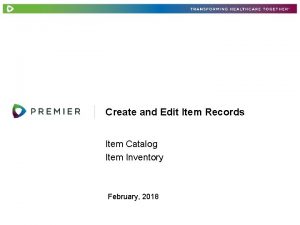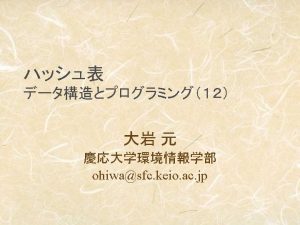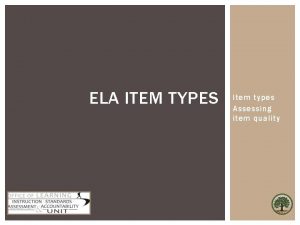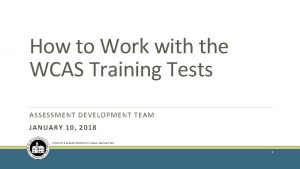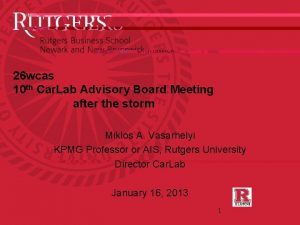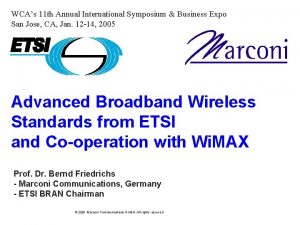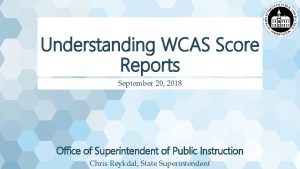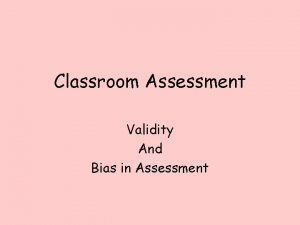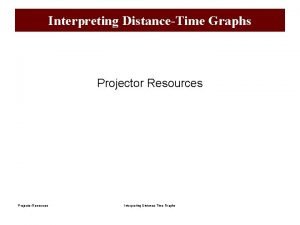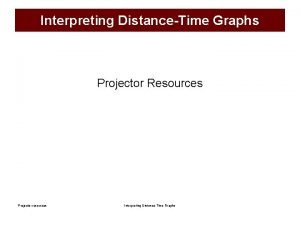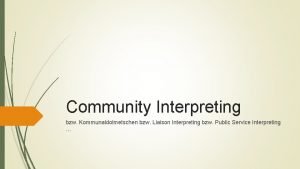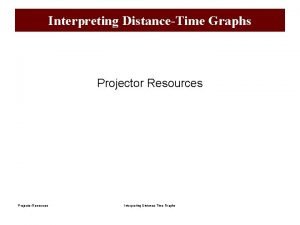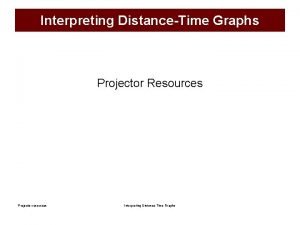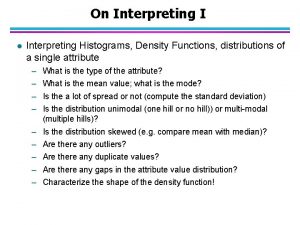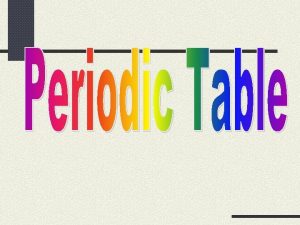Interpreting WCAS Item Specifications for Classroom Assessment 1
































































- Slides: 64

Interpreting WCAS Item Specifications for Classroom Assessment 1

Objectives • Participants will gain an understanding of how WCAS design and development can be used to inform classroom instruction and assessment that is aligned to the state science standards. The state science standards are the Next Generation Science Standards (NGSS). • Participants will build their capacity to interpret the item specifications to develop multidimensional items aligned to classroom instruction formative and/or summative use. 2

Contents Introduction to WCAS Test Design and Item Specifications Structure of an Item Specification Using an Item Specification to Write Items Aligned to Instruction Using a New S E P to Write Items Aligned to Instruction 3

Introduction to the WCAS Test Design & Item Specifications 4

WCAS Test Design & Item Specifications Overview This document includes: • Purpose • Structure of the Test • Item Types • Test Design • Standards Overview • Resources and References • Item Specifications • S E P, DCI, and CCC Vocabulary 5

WCAS Educator Resources https: //k 12. wa. us/studentsuccess/testing/state-testingoverview/washingtoncomprehensive-assessmentscience/wcas-educatorresources 6

WCAS Educator Resources https: //k 12. wa. us/studentsuccess/testing/state-testingoverview/washingtoncomprehensive-assessmentscience/wcas-educatorresources 7

WCAS Educator Resources https: //k 12. wa. us/studentsuccess/testing/state-testingoverview/washingtoncomprehensive-assessmentscience/wcas-educatorresources 8

WCAS Educator Resources https: //k 12. wa. us/studentsuccess/testing/state-testingoverview/washingtoncomprehensive-assessmentscience/wcas-educatorresources 9

WCAS Educator Resources https: //k 12. wa. us/studentsuccess/testing/state-testingoverview/washingtoncomprehensive-assessmentscience/wcas-educatorresources 10

Science Assessment Professional Development Opportunities https: //k 12. wa. us/studentsuccess/resources-subjectarea/scienceassessment-professionaldevelopment-opportunities 11

Structure of an Item Specification 12

4 -E S S 3 -2 Front Page 13

4 -E S S 3 -2 Front Page 14

4 -E S S 3 -2 Front Page 15

4 -E S S 3 -2 Back Page 16

4 -E S S 3 -2 Back Page 17

Details and Clarifications: A Closer Look 18

Details and Clarifications: A Closer Look 19

Details and Clarifications: A Closer Look 20

MS-E S S 3 -2 Front Page 21

MS-E S S 3 -2 Front Page 22

MS-E S S 3 -2 Front Page 23

MS-E S S 3 -2 Back Page 24

MS-E S S 3 -2 Back Page 25

Details and Clarifications: A Closer Look 26

Details and Clarifications: A Closer Look 27

Details and Clarifications: A Closer Look 28

HS-E S S 2 -4 Front Page 29

HS-E S S 2 -4 Front Page 30

HS-E S S 2 -4 Front Page 31

HS-E S S 2 -4 Back Page 32

HS-E S S 2 -4 Back Page 33

Details and Clarifications: A Closer Look 34

Details and Clarifications: A Closer Look 35

Details and Clarifications: A Closer Look 36

Item Writing Part A: Using an Item Specification to Write Items Aligned to Instruction 37

From PE to Instruction to Assessment PEs describe what students should know and be able to do at the end of instruction. Instruction aligned to a PE begins with a phenomenon and ends with students making sense of the phenomenon. Assessment aligned to a PE elicits evidence of student learning for either summative or formative purposes. 38

Item Development Process Developing an item aligned to a PE is a multi-step process: • Review the PE and the associated item specification • Determine a phenomenon and a context • Find authentic data to support the context • Choose an item type • Draft the item 39

Reviewing the PE and Item Specification (1) An item specification provides guidance for the development of two- and threedimensional items. Work in your small group to: • Choose a PE and its item specification. Read the PE, foundation boxes, assessment boundary (if present) and clarification statement (if present). • Identify the dimensions addressed by each set of bullets in the Details and Clarifications on the second page. • For each set of bullets, brainstorm one or two additional examples that are relevant to your students and your instruction. 40

Scientific Phenomena The NGSS website defines scientific phenomena as observable events that students can use three dimensions (S E P, DCI, CCC) to explain or make sense of. The use of phenomena in item development provides: • a context in which to demonstrate transfer of knowledge and skills, • a focus for combining knowledge and abilities from multiple dimensions, and • an element of interest and motivation for the student. Sample phenomena: • Sunflowers in my garden follow the sun; sometimes the moon can be seen during the day; the tetherball rope broke and the ball flew off in a straight line; water on the sidewalk in sunny areas evaporates faster than water in shady areas; my mother’s silver ring tarnished but her gold ring did not; one of my teacher’s cats has six toes. 41

Reviewing the PE and Item Specification (2) Work in your small group to identify the item specification statement for the dimensions your group will use to draft an item idea. • For example, the second item specification statement, designated by “. 2”, would be used to develop an item aligned to the S E P and the DCI. Use the examples brainstormed for the bullets in the Details and Clarifications to draft an item idea aligned to the chosen item specification statement. The item idea should include: a scientific phenomenon, a brief description of what you want to ask students, and a brief description of a correct student answer. 42

Determine a Context • A complete question should include introductory material that presents the context to students. • Introductory material provides background information to remove potential bias (e. g. , level the playing field) with regard to the context. o The introductory material is necessary, but not sufficient, to answer the item; the item should require that students apply their knowledge of the dimensions to engage with the task. o The introductory material includes information necessary to understand the context without giving away the answer. 43

Find Authentic Data (1) • Introductory material should include data. • Data is used by students to: • make and support claims; • demonstrate ability to do practices; and • apply crosscutting concepts to understand phenomena. • Data can be qualitative or quantitative. • Data should be authentic. 44

Find Authentic Data (2) Possible types of data: Possible formats: • Qualitative or quantitative • Diagrams • Measurements • Charts • Observations • Tables • Technical information or specifications • Graphs • Outcomes of investigations • Descriptions • Videos 45

Item Types Crosswalk: Strengths Item Type Description Edit task inline choice Filling in blanks Strengths Identifying associations, relationships, computations Grid interaction Making or completing Completing models, graphically representing concepts a model or graph Hot text Ordering statements Multiple choice/ Multiple select Selecting an option or options from a list Composing an answer using sentences Entering a numerical answer in a table Selecting cells in a table Short answer Table input Table match Completing models, representing concepts or relationships Useful for explanations, reasoning, claims Allows students to explain in their own words Computations Identifying cause-and-effect relationships, categorizing statements (e. g. , evidence/not evidence) Multi-Part Items: Item parts can be combined to achieve two- or three-dimensional alignment to a PE. For example: Students identify a claim based on evidence in part A and then describe the evidence that supports the claim in part B. 46

Item Types: Edit Task Inline Choice Online Example Paper Example Grade 8 Training Test Item 7 47

Item Types: Drag and Drop Grid Online Example Paper Example Grade 5 Training Test Item 4, Part A 48

Item Type: Draw Arrows Grid Online Example Paper Example Grade 5 Training Test Item 2, Part A 49

Item Types: Hot Text Online Example Paper Example Grade 8 Training Test Item 1, Part A 50

Item Types: Table Match Online Example Paper Example Grade 8 Training Test Item 1, Part A 51

Item Type: Table Input Online and Paper Example Grade 11 Training Test Item 1, Part A 52

Item Type: Short Answer 53 Grade 5 Training Test Item 9

Discussion: Item Types Discuss in your small groups: • What types of items are your students familiar with? • How do the various item types lend themselves to assessing the S E P? DCI? CCC? • What technologies are available for developing online versions of classroom assessment items? • Which item type(s) would be most appropriate for your item idea? 54

Writing Time • Using the PE and item specification for guidance, draft an item based on your context, data, and item type. • Peer review to give and receive feedback • Revise 55

Item Writing Part B: Using a New S E P to Write Items Aligned to Instruction 56

S E P’s in the Classroom (1) Each PE includes a single S E P. For example, the S E P for MS-PS 1 -2 is Analyzing and Interpreting Data. • MS-PS 1 -2: Analyze and interpret data on the properties of substances before and after the substances interact to determine if a chemical reaction has occurred. Instruction aligned to this PE might start with a phenomenon: • A clear solution of limewater becomes white and cloudy when using a straw to blow air into it. Instruction designed to help students achieve the goal described by the PE will likely include other S E P’s in addition to Analyzing and Interpreting. 57

S E P’s in the Classroom (2) Consider ways that these S E P’s might be incorporated into instruction during the unit. • Asking Questions and Defining Problems • Developing and Using Models • Planning and Carrying Out Investigations 58

S E P’s in the Classroom (3) • Classroom instruction provides opportunities for students to use many S E P’s in the process of making sense of a phenomenon. • Although an item specification is written to the S E P, D C I, and CCC for a specific PE, the details and clarifications can be used to develop other combinations of S E P’s, DCI’s, and CCC’s. 59

A Closer Look at the S E P’s in the Item Specifications • Consider the Details and Clarifications for the example PE, MS-PS 1 -2: • MS-PS 1 -2: Analyze and interpret data on the properties of substances before and after the substances interact to determine if a chemical reaction has occurred. • The first bullet in the Details and Clarifications reflects the language used in the PE to describe the S E P. • Analyze and/or interpret data is expanded to include. . . • Within a grade band, the sub-bullets for a given S E P are always the same. 60

Writing Time • Select a new S E P for the PE and item specification you used in Item Writing Part A. • Use the S E P bullet and sub-bullets to draft a new item aligned to the different S E P. 61

Closing Thoughts and Reflections 62

Reflections • What did you learn that you will use in your classroom? • What do you want to think more about? • What questions do you still have? • What do you need to move forward? • How can you leverage partnerships to continue this work? 63

Thank You For more information, please email the OSPI Science Team: science@k 12. wa. us 64
 Wcas practice test
Wcas practice test Metafora
Metafora Btech smart classes
Btech smart classes Lpat classroom language assessment
Lpat classroom language assessment Language assessment: principles and classroom practices
Language assessment: principles and classroom practices Language assessment: principles and classroom practices
Language assessment: principles and classroom practices Fspos vägledning för kontinuitetshantering
Fspos vägledning för kontinuitetshantering Typiska drag för en novell
Typiska drag för en novell Tack för att ni lyssnade bild
Tack för att ni lyssnade bild Returpilarna
Returpilarna Varför kallas perioden 1918-1939 för mellankrigstiden
Varför kallas perioden 1918-1939 för mellankrigstiden En lathund för arbete med kontinuitetshantering
En lathund för arbete med kontinuitetshantering Särskild löneskatt för pensionskostnader
Särskild löneskatt för pensionskostnader Personlig tidbok fylla i
Personlig tidbok fylla i A gastrica
A gastrica Vad är densitet
Vad är densitet Datorkunskap för nybörjare
Datorkunskap för nybörjare Tack för att ni lyssnade bild
Tack för att ni lyssnade bild Mall för debattartikel
Mall för debattartikel Delegerande ledarskap
Delegerande ledarskap Nyckelkompetenser för livslångt lärande
Nyckelkompetenser för livslångt lärande Påbyggnader för flakfordon
Påbyggnader för flakfordon Lufttryck formel
Lufttryck formel Offentlig förvaltning
Offentlig förvaltning Jag har gått inunder stjärnor text
Jag har gått inunder stjärnor text Presentera för publik crossboss
Presentera för publik crossboss Vad är ett minoritetsspråk
Vad är ett minoritetsspråk Kanaans land
Kanaans land Treserva lathund
Treserva lathund Epiteltyper
Epiteltyper Claes martinsson
Claes martinsson Cks
Cks Programskede byggprocessen
Programskede byggprocessen Mat för idrottare
Mat för idrottare Verktyg för automatisering av utbetalningar
Verktyg för automatisering av utbetalningar Rutin för avvikelsehantering
Rutin för avvikelsehantering Smärtskolan kunskap för livet
Smärtskolan kunskap för livet Ministerstyre för och nackdelar
Ministerstyre för och nackdelar Tack för att ni har lyssnat
Tack för att ni har lyssnat Referatmarkering
Referatmarkering Redogör för vad psykologi är
Redogör för vad psykologi är Borstål, egenskaper
Borstål, egenskaper Tack för att ni har lyssnat
Tack för att ni har lyssnat Borra hål för knoppar
Borra hål för knoppar Vilken grundregel finns det för tronföljden i sverige?
Vilken grundregel finns det för tronföljden i sverige? Varians
Varians Tack för att ni har lyssnat
Tack för att ni har lyssnat Rita perspektiv
Rita perspektiv Verksamhetsanalys exempel
Verksamhetsanalys exempel Tobinskatten för och nackdelar
Tobinskatten för och nackdelar Toppslätskivling dos
Toppslätskivling dos Handledning reflektionsmodellen
Handledning reflektionsmodellen Egg för emanuel
Egg för emanuel Elektronik för barn
Elektronik för barn Mantel som bars av kvinnor i antikens rom
Mantel som bars av kvinnor i antikens rom Strategi för svensk viltförvaltning
Strategi för svensk viltförvaltning Var 1721 för stormaktssverige
Var 1721 för stormaktssverige Humanitr
Humanitr Ro i rom pax
Ro i rom pax Tack för att ni lyssnade
Tack för att ni lyssnade Matte större än tecken
Matte större än tecken Bunden poesi
Bunden poesi Inköpsprocessen steg för steg
Inköpsprocessen steg för steg Rbk mätning
Rbk mätning Ledarskapsteorier
Ledarskapsteorier
